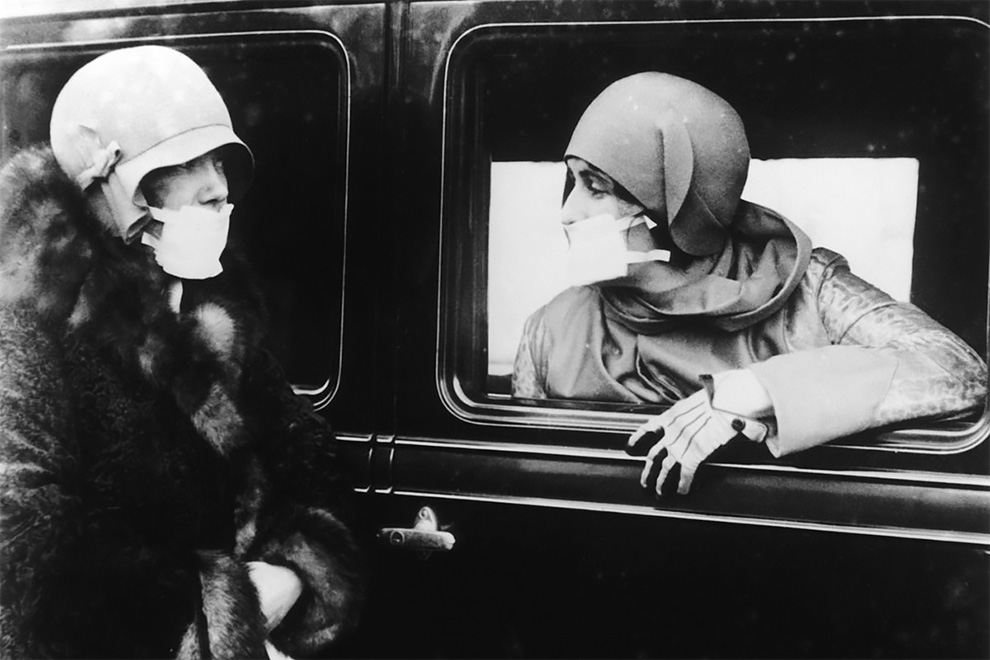Historical Photos Of The 1918 Spanish Flu That Show What A Global Pandemic Looked Like In The 1910s
California, 1918. The 1918 Spanish flu killed up to 50 million people around the world and has been called “the mother of all pandemics”.

Between 1918 and 1919, an outbreak of influenza spread rapidly across the world, and killed more than 50 million—and possibly as many as 100 million—people within 15 months.
The speed of the pandemic was shocking; the numbers of dead bodies overwhelmed hospitals and cemeteries. Quarantine centers, emergency hospitals, public use of gauze masks, and awareness campaigns were all undertaken swiftly to halt the spread. But as World War I was coming to a close, millions of soldiers were still traveling across the globe, aiding the spread of the disease.
The flu was first observed in Europe, the US and parts of Asia before it quickly spread throughout the world. It was wrongly named the Spanish flu because it was first reported in the Madrid daily newspaper ABC. However, modern scientists now believe the virus could have started in Kansas, US. In 1918, there was no vaccination to protect against flu. It was later discovered that in many victims the vicious virus had invaded their lungs and caused pneumonia.
Gathered here are images from the battle against one of the deadliest events in human history, when the flu killed up to 6 percent of the Earth’s population in just over a year.
h/t: vintag.es
A U.S. Army camp hospital in Aix-Les-Baines France during World War I. It is estimated that 20 percent – 40 percent of U.S. soldiers and sailors were ill, primarily from influenza virus, during the height of the war causing tremendous suffering and impacts on mission readiness. (Corbis / National Geographic)

Policemen stand in a street in Seattle, Washington, wearing protective masks made by the Seattle Chapter of the Red Cross, during the influenza epidemic in 1918. (National Archives)

Combating influenza in Seattle in 1918, workers wearing masks on their faces in a Red Cross room. (National Archives)

Corpsmen in caps and gowns ready to attend patients in the influenza ward of the U.S. Naval Hospital on Mare Island, California, on December 10, 1918. (U.S. Navy)

Influenza victims crowd into an emergency hospital near Fort Riley, Kansas in 1918. (National Museum of Health / AP)

A typist wears her influenza mask in October of 1918. Worried by the hold that disease had taken in New York City, practically all workers covered their faces in gauze masks as a protection against disease. (National Archives)

Court is held in the open air in San Francisco in 1918. (Bettmann / Bettmann Archive)

The congregation prays on the steps of the Cathedral of Saint Mary of the Assumption, where they gathered to attend mass and pray during the influenza epidemic, in San Francisco, California. (Bettmann / Bettmann Archive)
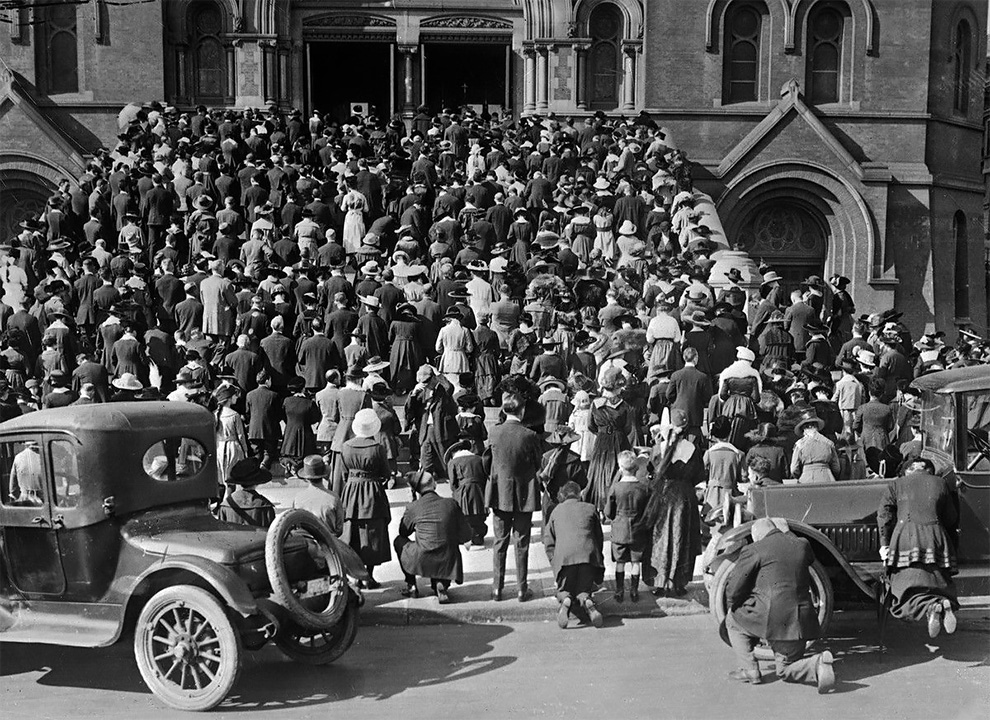
While schools were closed during the influenza pandemic, many American children made toys for refugee children overseas. (National Archives)
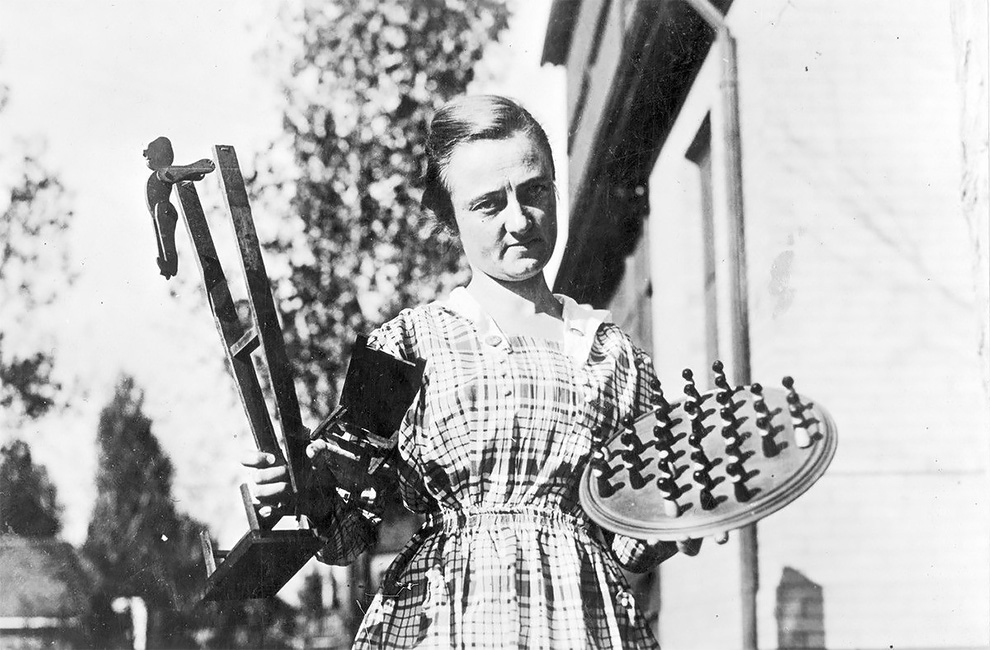
The U.S. Army 39th regiment wear masks to prevent influenza in Seattle in December of 1918. The soldiers are on their way to France. (Everett Historical / Shutterstock)
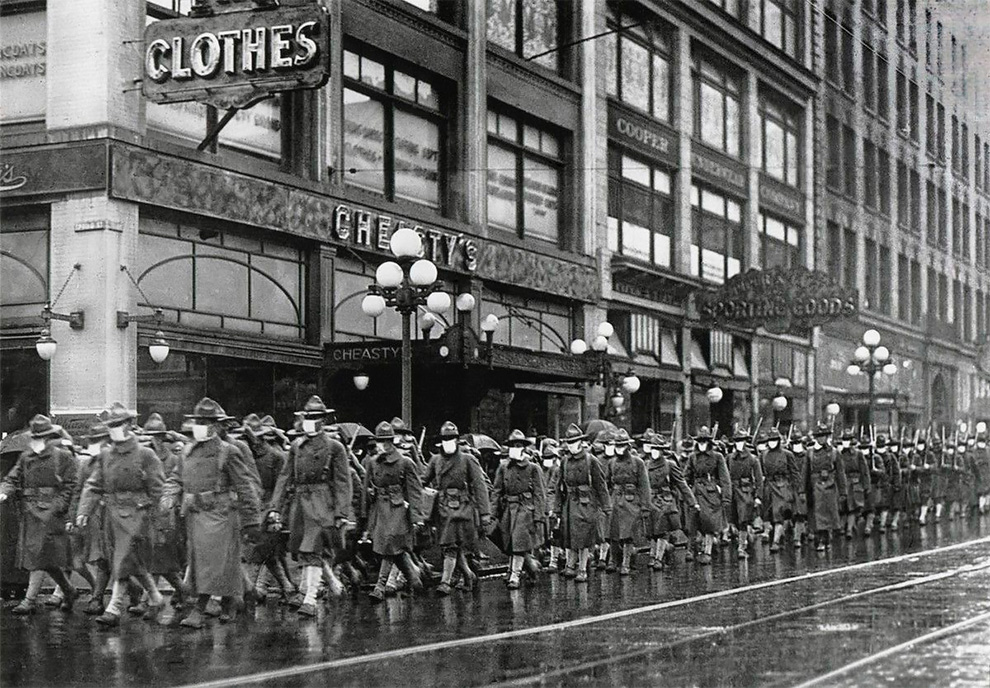
Japanese school girls wear protective masks to guard against the influenza outbreak. (Bettmann / Bettmann Archive)
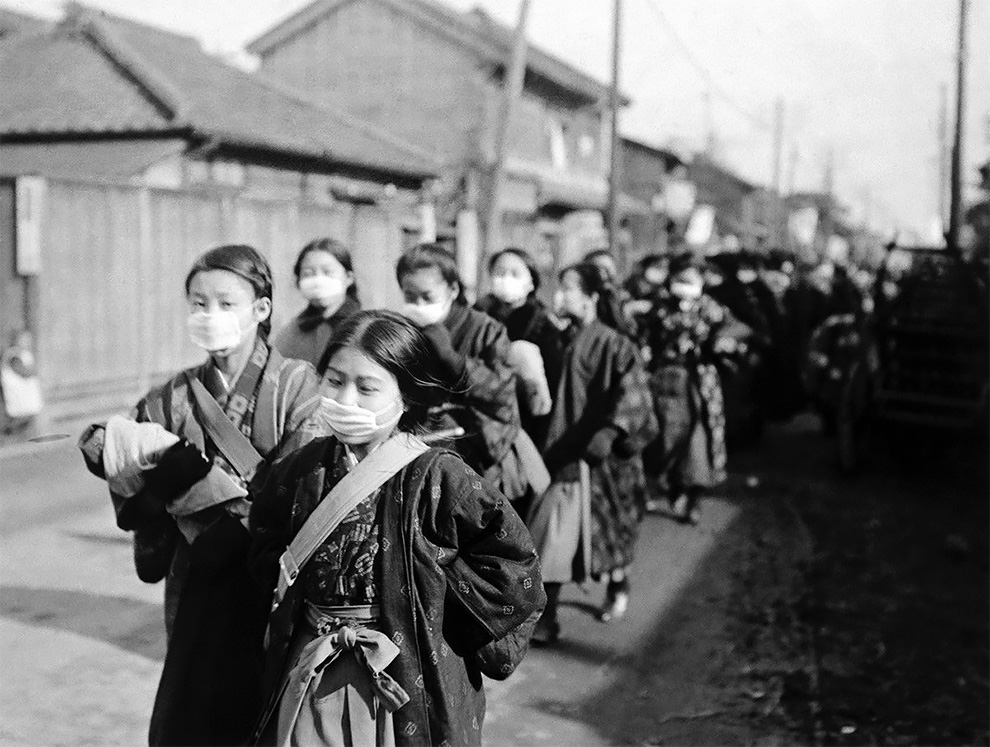
A girl stands next to her sister, who is lying in bed, in November of 1918. The young girl became so worried that she telephoned the Red Cross Home Service, which came to help the woman fight the influenza virus. (Library of Congress via AP)

Red Cross Motor Corps members on duty during the influenza epidemic in the United States, in St. Louis, Missouri, in October of 1918. (National Archives)

An emergency hospital set up in Brookline, Massachusetts, to care for influenza cases, photographed in October of 1918. (National Artchives)

Convalescing influenza patients, isolated due to an overcrowded hospital, stay at the U.S. Army’s Eberts Field facilities in Lonoke, Arkansas, in 1918. (National Archives)
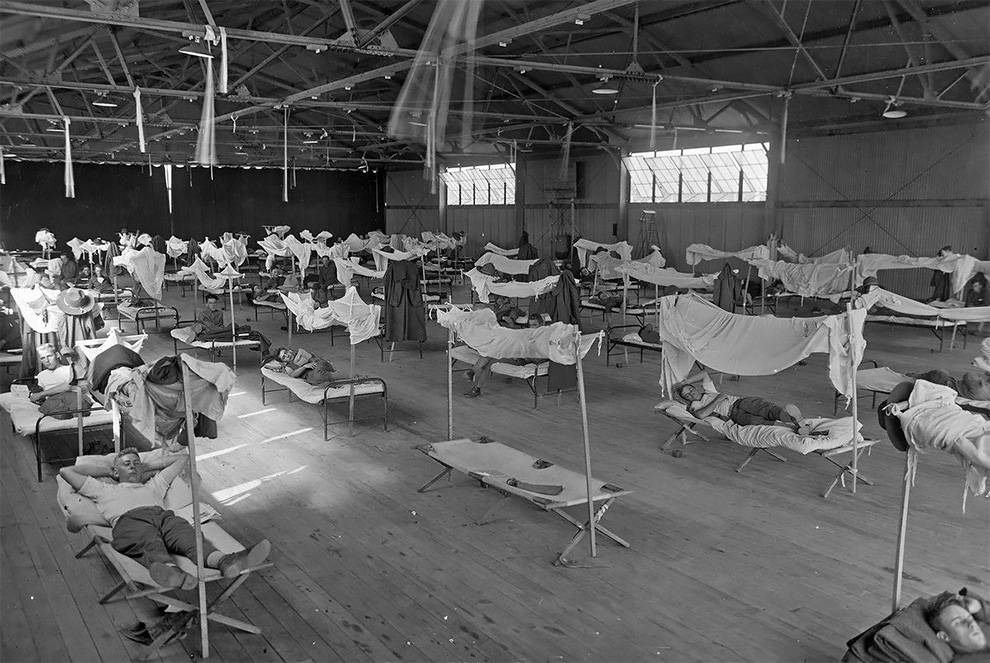
A nurse takes the pulse of a patient in the influenza ward of the Walter Reed hospital in Washington, D.C., in November of 1918. (Library of Congress via AP)
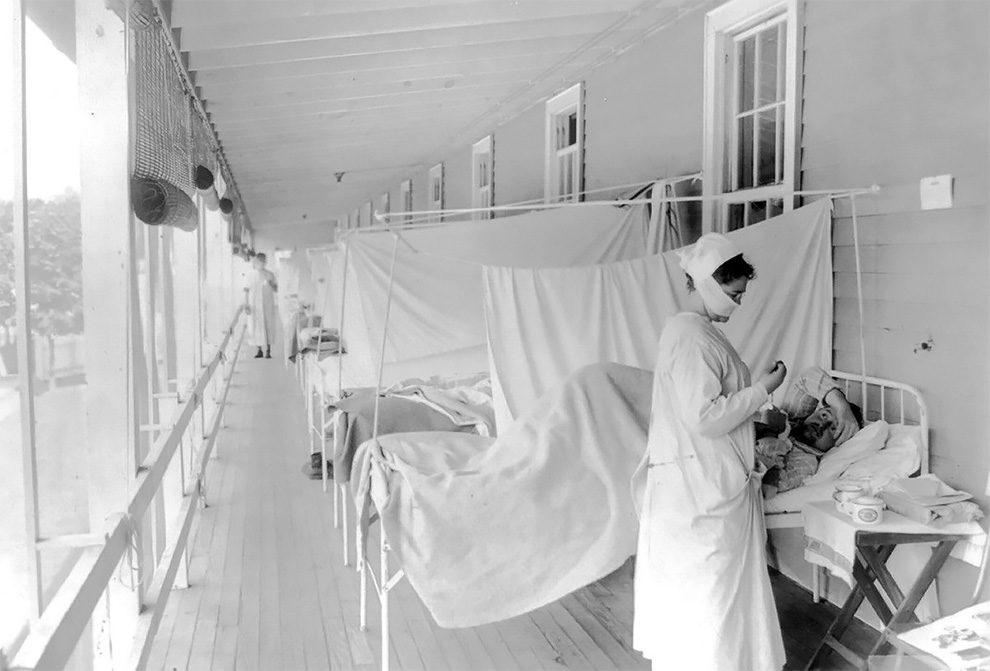
A telephone operator wears protective gauze in 1918. (Bettmann / Bettmann Archive)
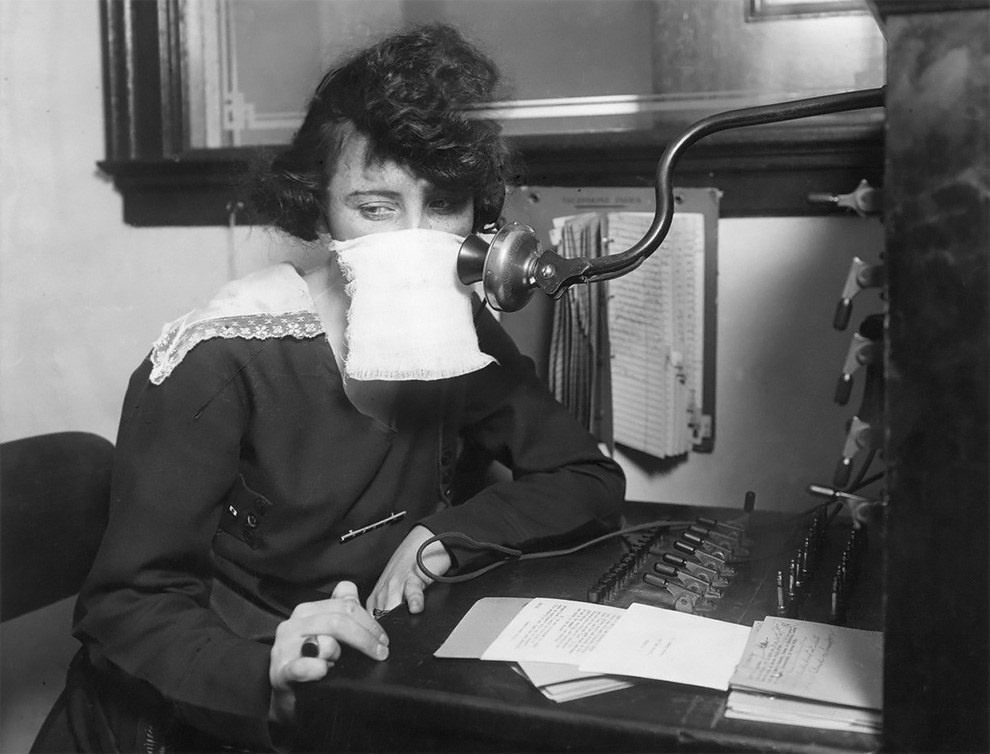
Recovering soldiers watch a motion picture show wearing flu masks at U.S. Army Hospital Number 30 in Royat, France. (U.S. National Library of Medicine)

An American soldier has his throat sprayed to prevent influenza in December of 1918 at Love Field in Dallas, Texas. (Everett Historical / Shutterstock)

Soldiers gargle with salt water to prevent influenza on September 24, 1918, at Camp Dix, New Jersey. (Everett Historical / Shutterstock)

Volunteer nurses from the American Red Cross tend to influenza patients in the Oakland Municipal Auditorium, used as a temporary hospital in 1918. (Edward A. “Doc” Rogers / Library of Congress via AP)

A scene in the influenza camp at Lawrence, Maine, where patients are given fresh air treatment. This extreme measure was hit upon as the best way of curbing the epidemic. Patients are required to live in these camps until cured. (Bettmann / Bettmann Archive)
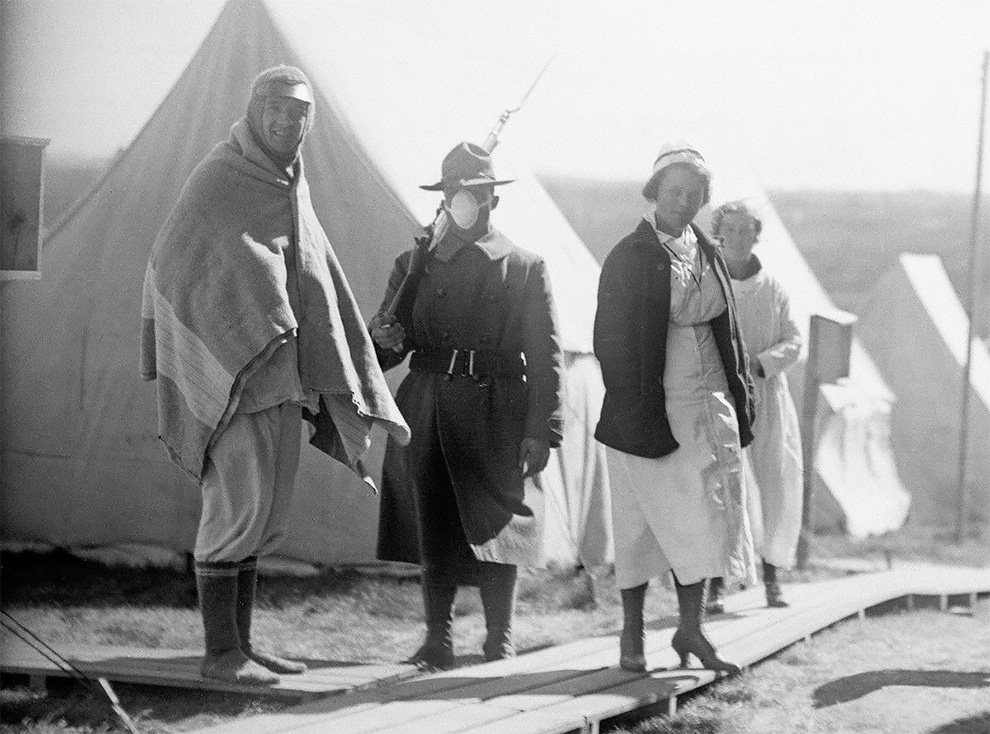
British Red Cross nurses close to the front line in Flanders, wearing their gas masks, against the threat of German gas attacks. Doctors and nurses faced the same realities of war as the soldiers they were treating. (Bentley Archive / Getty Images)

American nurses carrying gas masks walk through a trench in France, 1918. (Hulton Archive / Getty Images)
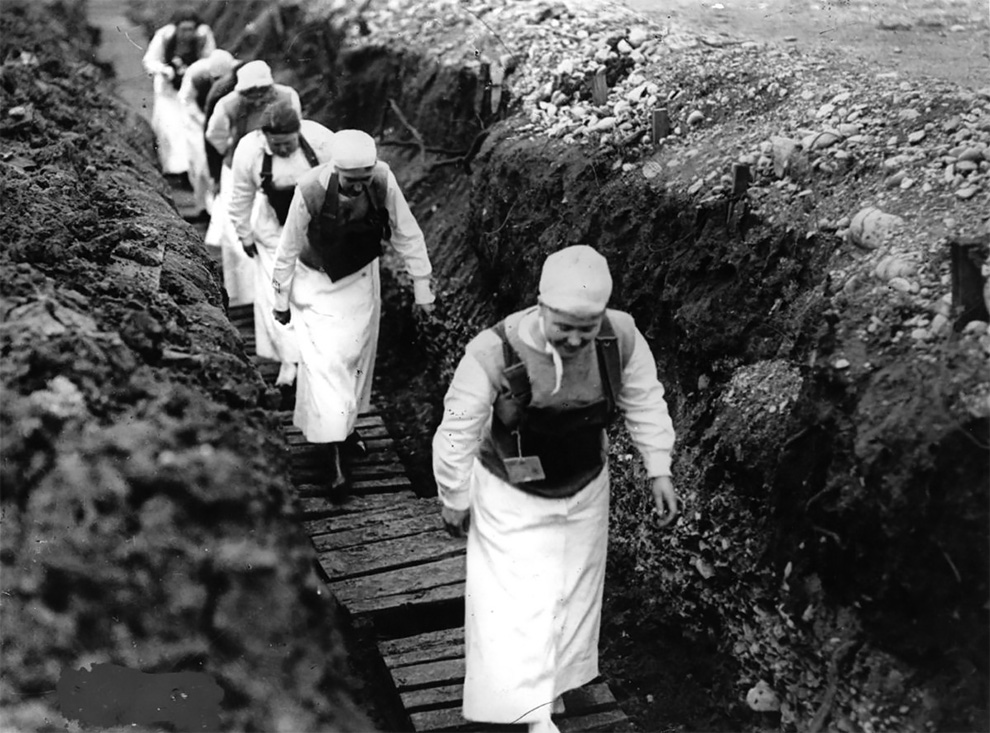
Red Cross nurses and a patient at the Red Cross Emergency Ambulance Station in Washington, DC, 1918. (Underwood Archives / Getty Images)
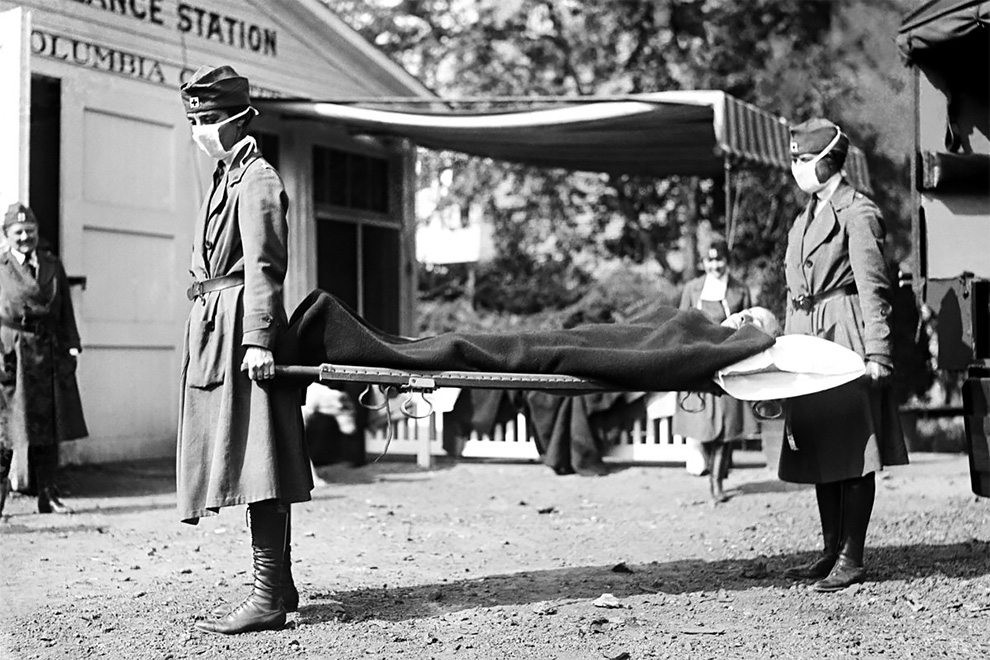
Nurses care for victims of the Spanish flu epidemic in Lawrence, Massachusetts, 1918. (Hulton Archive / Getty Images)

Baseball players at the height of the Spanish flu, 1918. (Underwood And Underwood / Getty Images)

An open-air barber shop. Public events were encouraged to be held outdoors to hinder the spread of the disease during the influenza epidemic. Photographed at the University of California, Berkeley, in 1919. (National Archives)
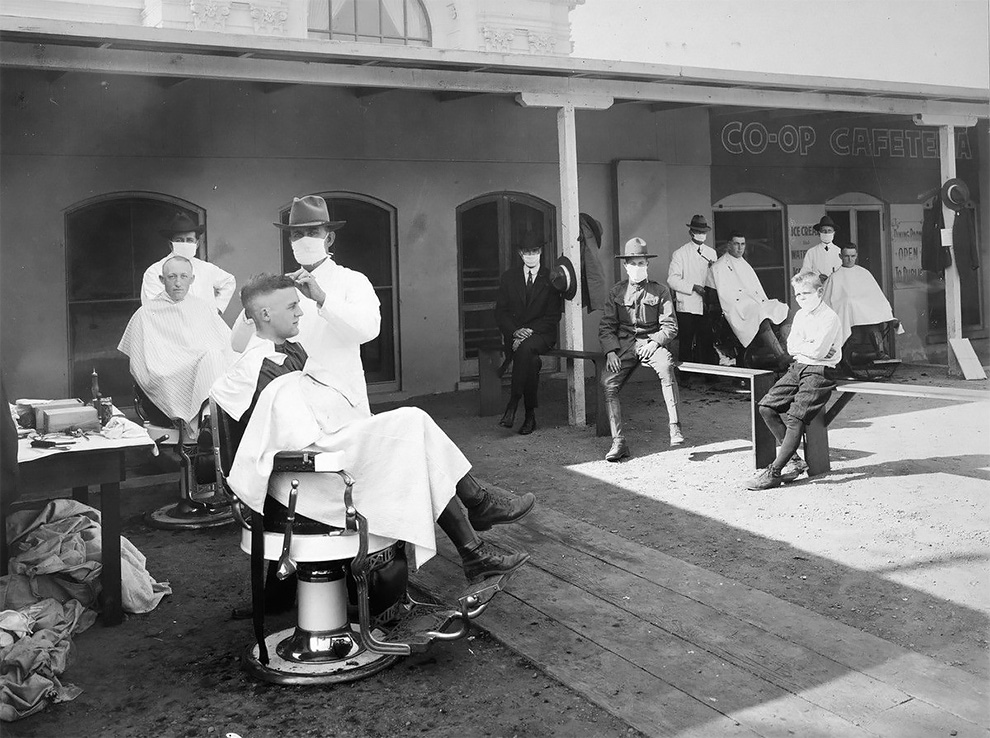
Physics class, University of Montana, Missoula, 1919. During the influenza epidemic, classes were held outdoors. (National Archives)
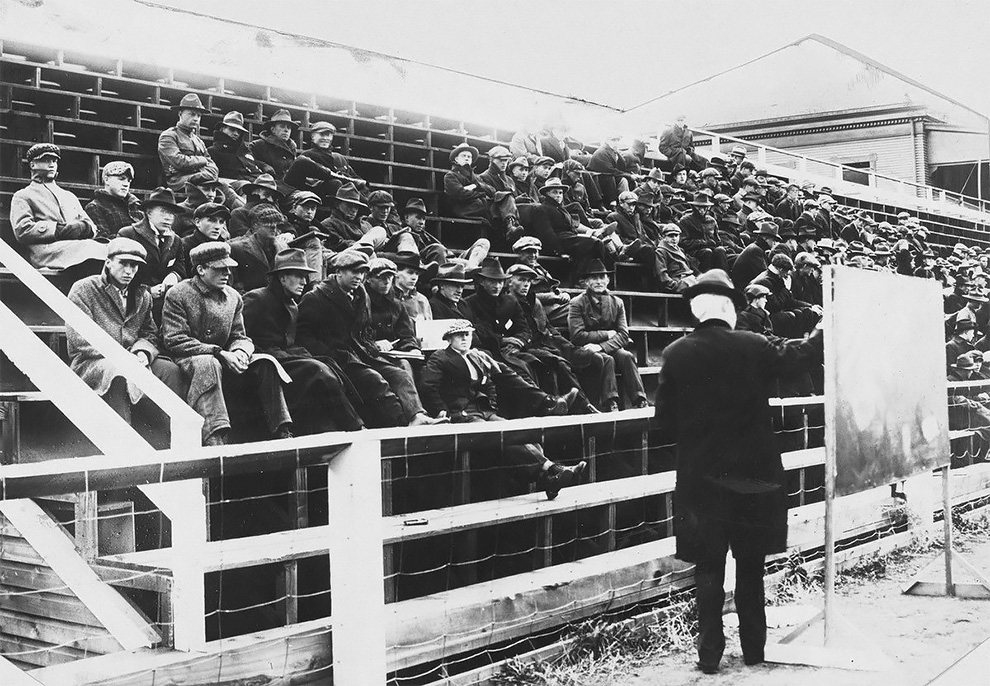
In Sydney, Australia, nurses leave Blackfriars Depot in Chippenedale during the flu epidemic in April of 1919. (NSW State Archives / Tara Majoor)
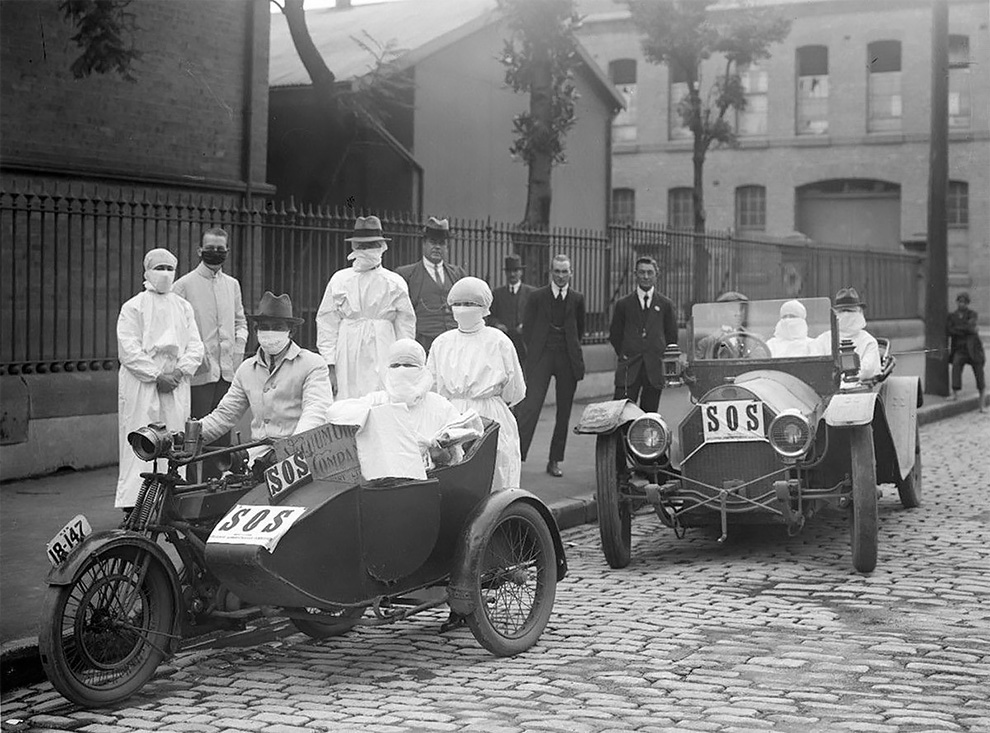
People arrive at a quarantine camp in Wallangarra, Australia, during the influenza epidemic of 1919. (State Library of Queensland)

Nurses in Boston hospitals are equipped with masks to fight influenza in the spring of 1919. (National Archives)
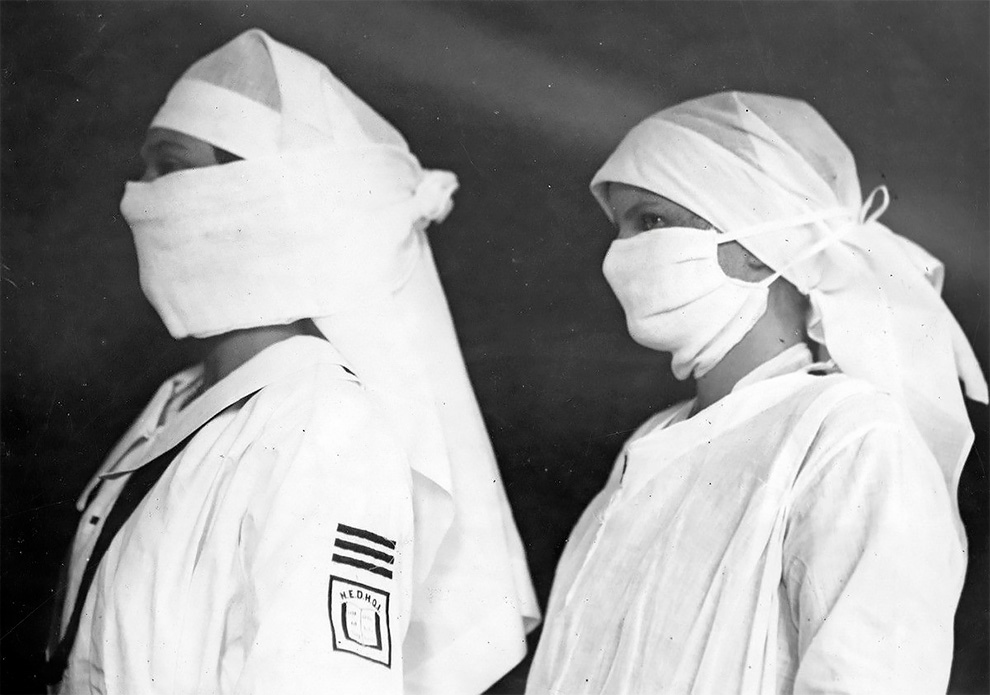
Serbian soldiers are treated for influenza on February 5, 1919, in Rotterdam, Netherlands, at the auxiliary hospital for Serbians and Portuguese. The auxiliary hospital was located in Schoonderloostraat, the building of the Society of St. Aloysius. In the center is Captain Dragoljub N. Đurković with a member of the medical staff. (CC BY-SA H.A. van Oudgaarden, courtesy of Piet van Bentum)
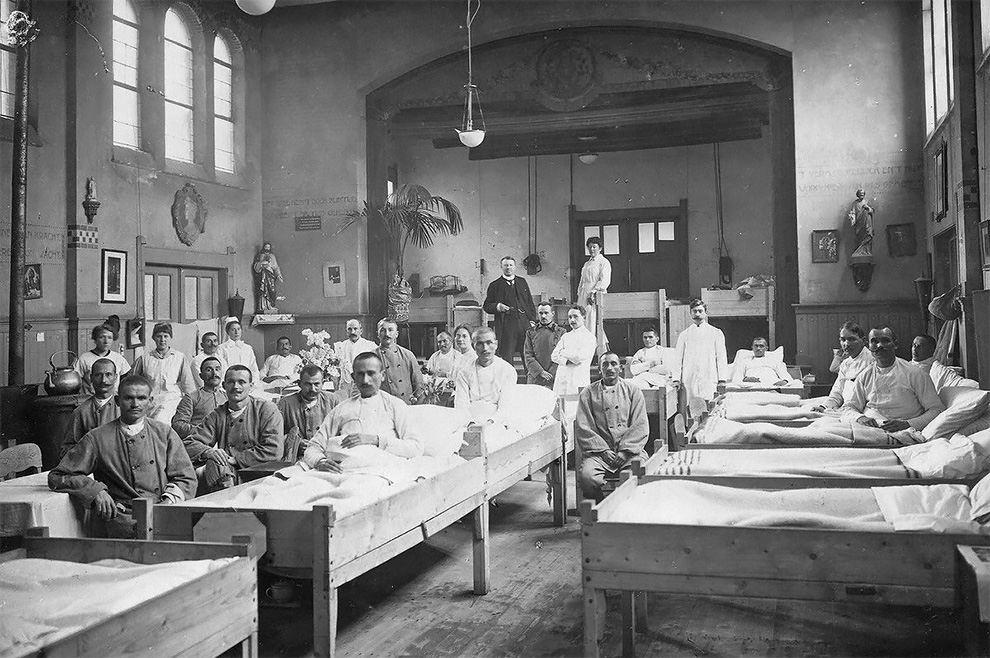
A woman wears a flu mask during the Spanish flu epidemic Feb. 27, 1919. (Hulton Deutsch / Getty Images)
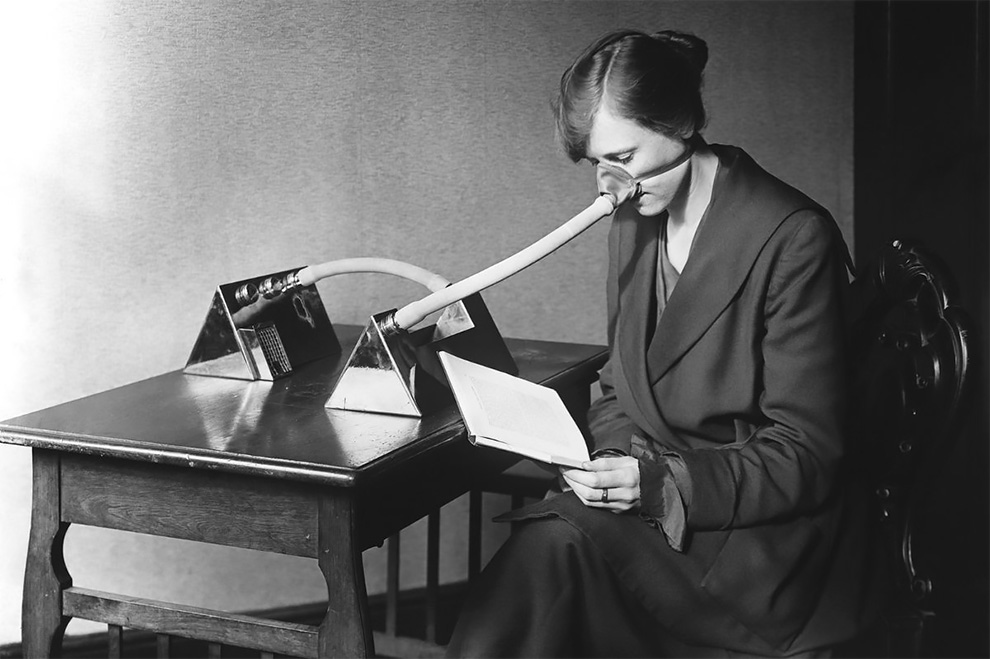
Original caption from the National Archives: “February, 1919. U.S. Army at Archangel Front, Russia. Funeral of member of crew of U.S.S. Ascutney. Three members died in Archangel and many were sick with influenza.” (National Archives)
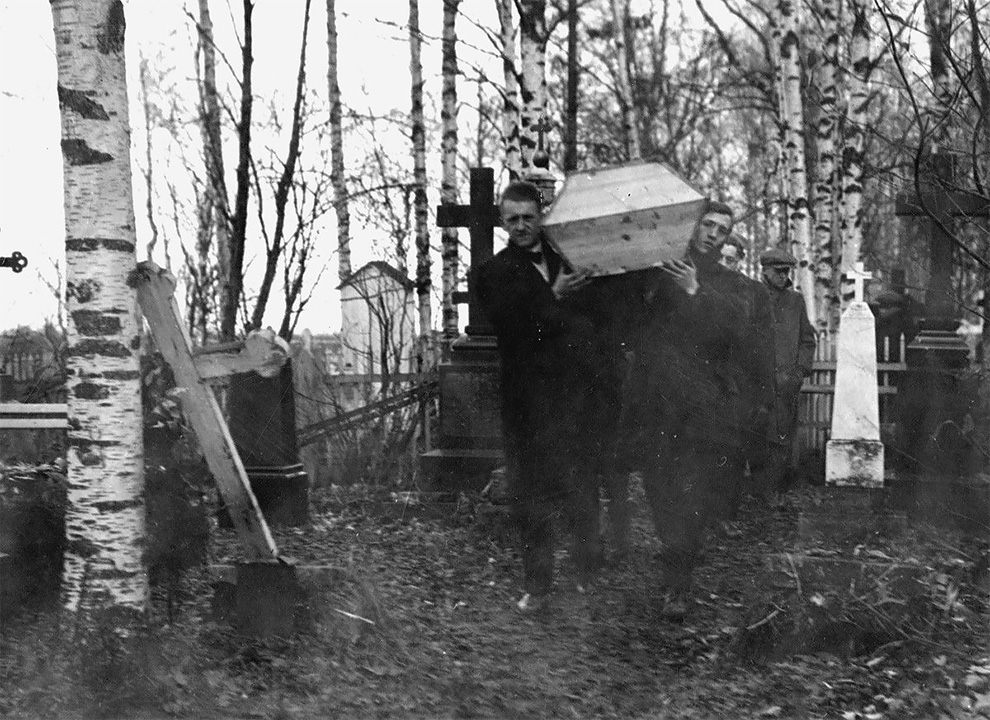
Graves of U.S. soldiers who died of influenza in Devon, England, photographed on March 8, 1919. The graves contain the bodies of 100 American wounded soldiers at Paignton Military Hospital that died from the epidemic of influenza that spread over England. (National Archives)
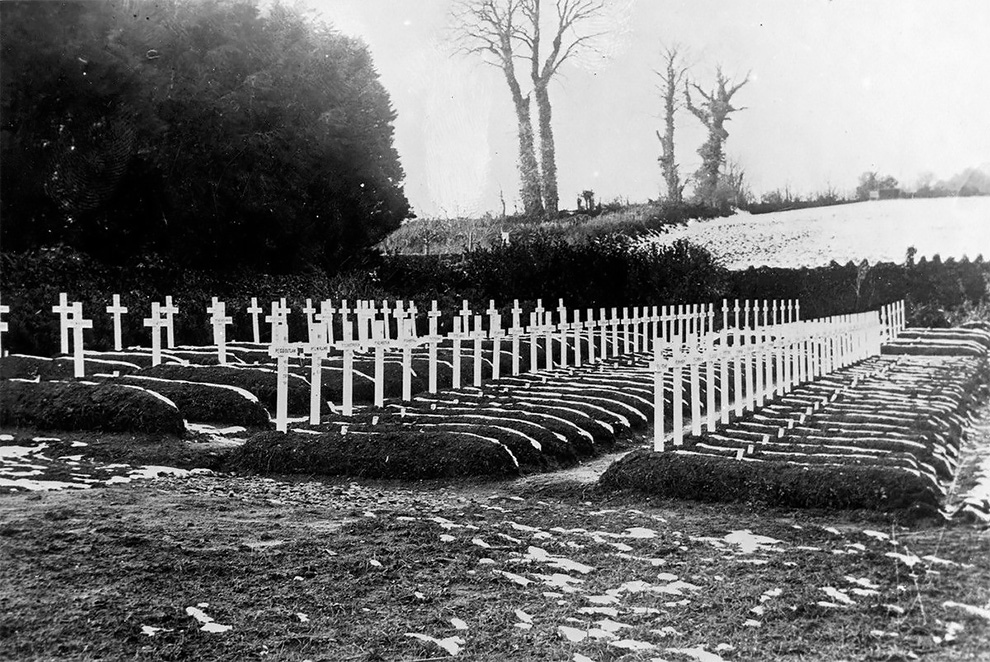
A health warning about influenza from the Anti-Tuberculosis League, posted on the inside of a public transport vehicle. (Cincinnati Museum Center / Getty Images)

A UK man sprays the top of a bus with an anti-flu gas March 2, 1920. (Davis / Getty Images)

Two women wearing flu masks during the flu epidemic. (Keystone / Getty Images)
